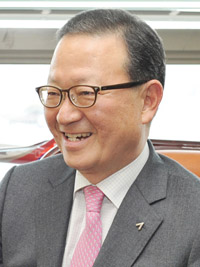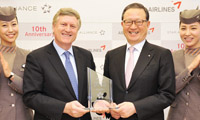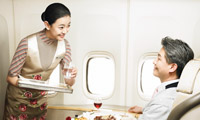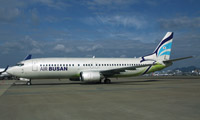Cover Story
ASIANA STANDS TALL
Exactly 25 years ago, Asiana Airlines was launched to take on the might of national carrier, Korean Air. Today, it’s no longer David versus Goliath as president Young-Doo Yoon leads the airline into a new and confident era – with A380s and A350s on the order books
April 1st 2013
The year 1988 is fondly remembered by Koreans as the eyes of the world were focused on the Seoul Olympics. Read More »
 |
| 'Our strengths include our location in Northeast Asia. Our coverage of major and secondary destinations in China and Japan is unequalled' |
| Young-Doo Yoon President Asiana Airlines |
But another event in the same year went unnoticed by the world at large, and even in Korea, where it was lost among the Olympic fervour. It was the launch of Asiana Airlines, funded by the giant conglomerate, Kumho Group, to take on the might of national carrier, Korean Air.
Today, as the airline celebrates its 25th anniversary – and 10th anniversary as a Star Alliance member – Asiana is among the world’s top airlines operating from its base at one of the world’s premier airports, Incheon International in Seoul. By the end of 2013 it will have a fleet of 84 aircraft.
But back on December 23, 1988, when Asiana launched its first service from Seoul’s Gimpo International Airport to Busan and Gwangju, it had just two B737s. It dipped its toe into the international market a little over a year later with a service between Seoul and Japan’s Narita Airport.
Today, Asiana operates a network spanning 91 international passenger routes, 14 domestic routes and 24 all-cargo services. It holds a 23.5% share of the Korean international passenger market and a 21% share of the domestic market.
Hands-on president, Young-Doo Yoon (61), has been at the helm of Asiana for five years. He joined the airline as executive vice-president from another Kumho subsidiary, the Kumho Tire Company, in 2005. He spent 12 years in the U.S. with Kumho Tires and three years as president of the company’s European division.
“My experience was in manufacturing and not in a service industry. Up to that time my airline experience had been as a passenger,” Yoon told Orient Aviation.
He was appointed president of Asiana in 2008 and found himself facing the beginnings of one of the world’s worst financial crises. He did not need his skills as a meteorology graduate to see the storm clouds gathering over the airline industry.
Yoon learnt fast and despite, like the industry at large, suffering badly from escalating oil prices, has helped his airline expand its reputation for service. A few years ago, Asiana was David competing against the Goliath of Korean Air.
 |
| Asiana Airlines: will have a fleet of 84 aircraft by the end of 2013. By 2015, it will have increased its seat capacity by 25% in five years |
Today, they are fighting head-to-head. Next year, the first of Asiana’s six A380s will enter service. By 2017, the first of 30 A350s will join its fleet. In the next two years, Asiana will have increased its seat capacity over 2010 by 25%.
In the 2012 financial year, Asiana saw its operating profit slump 61% to 132.5 billion won (US$120.45 million), from 343.4 billion won in 2011, due mainly to high jet fuel prices. Revenues, however, were up 6% to 5.64 trillion won.
For 2013, Asiana is estimating a turnaround, with an operating profit of 360 billion won and revenues of 6.3 trillion won.
The focus of the current business plan is on maximizing profits from its international passenger business with a two-pronged approach of route expansion and premium sales growth.
The carrier forecasts revenue passenger kilometre (RPK) growth of 9% in the year compared to 2012, assisted by the introduction of new equipment and network expansion.
The airline’s earlier strategy was to develop strong short to medium-haul routes in Asia, notably China and Japan. Long haul routes – to North America and Europe – were limited.
However, two years ago the carrier started to increase frequency on existing long-haul routes and add new ones to the network.
| Asiana’s corporate emblem is derived from the traditional Korean multi-coloured stripes called ‘Saektong’, which symbolizes a joyful welcome and hospitality. |
Additional routes this year will include Jakarta daily from July and Bali twice weekly in the same month. Network expansion will see the frequency to Chongqing in China rise to daily from four weekly flights, boosting Yangon to four weekly flights from two and Chicago to daily from four weekly services.
Asiana will add two A321-200s to its narrowbody fleet in 2013, increasing its A320/321 fleet to 35. Its remaining two B737s will be retired. Two A330-300s will enter service in July and November respectively and a B777 featuring the new Asiana First Suite cabin will be delivered in July. This will bring the number of Asiana’s long-range, two-engine Boeing jets to 13. The carrier also operates four 747-400s on international long-haul routes.
The upgrading of Asiana’s B777 fleet with new business class cabins, featuring the ‘Quadra Smartium’ seat, has been completed and the remodelled aircraft are flying to long-haul destinations including London, San Francisco and Los Angeles and to key short to medium-range business traffic routes such as Kansai (Osaka) and Beijing.
Next year, the new A380s will be deployed on the existing long-haul routes of Los Angeles, New York and Frankfurt, which will free up the premium service equipped B777-200ERs for new routes to North America and Europe.
There is no disputing the importance of China and Japan to Asiana’s market.
“We currently operate 21 routes to 15 cities in Japan and 31 routes to 22 cities in China – the most destinations of any non-Chinese airline,” said Yoon.
 |
| Star Alliance chief executive, Mark Schwab, presents Asiana president, Young-Doo Yoon, with a memento on the 10th anniversary of the carrier’s Star membership |
“We have nine exclusive routes out of Incheon to destinations in Japan. No other carrier has such a network.”
In 2012, Japan routes constituted nearly 20% of Asiana’s international passenger revenue while China routes accounted for around 16%.
The number of Chinese tourists travelling to Korea last year rose 28% compared with 2011.
“We are the biggest carrier between the two countries in terms of frequency and passenger numbers, so this is a good opportunity for future growth,” said Yoon.
“Last year the number of Chinese travelling overseas was 78 million, of which 2.8 million, or 3.5%, came to Korea. That total could easily rise to 100 million. If 5% visit Korea, that’s five million Chinese travellers.”
Yoon expressed concern about recent disputes between Japan and Korea, based on historical and territorial issues, which in the last quarter of 2012 had contributed to traffic from Japan – notably group traffic - dropping by 23% over the same period in 2011. The devaluation of the Japanese yen also played its part in the visitor shortfall.
Yoon believes that with new governments in both countries the situation could soon return to normal. A glimmer of hope was the recent news that individual Japanese passengers increased year-on-year in December 2012.
Freight is of huge importance to Asiana. It comprised about 26% of total revenue in 2012, but currently lags behind the peak reached in 2010.
Korea’s Ministry of Land has forecast a 1% increase in cargo demand this year, but, by focusing on its high profit network, Asiana is hoping to boost revenue tonne kilometres by 6%. The carrier’s policy is to concentrate on major Korean manufacturers with plants outside Korea.
 |
| Asiana prides itself on its inflight service |
“This year cargo shipments – in value terms – seem to be about the same as last year. So we are trying to focus on profit first, instead of increasing the frequencies of our long-haul network,” said Yoon.
“We have a big opportunity when open skies kicks in at Japan’s Narita from March 31. Previously, we didn’t have the traffic rights, but that has changed. From April we will put our cargo flights into Narita so we can develop new business in the Japanese market.”
Hanoi, Vietnam, is also important to Asiana’s cargo division where Samsung Electronics has its largest factory for the manufacture of smartphones.
“At the end of 2012, we increased flights to Shanghai to daily. From March 31, we’ll increase cargo flights to Hanoi from two to four flights a week and also start flights to Narita this year. In 2012, Japan, China and Southeast Asia provided 30% of all cargo revenue,” said Yoon.
The Korean market has the second largest cargo volume in the world. Yoon believes the cargo business continues to hold great promise once the current difficult period passes.
The challenges facing Asiana: fuel prices, the threat of LCCs and exchange rate fluctuations, are not unique to the carrier.
Asiana has only a small domestic revenue base. Only 5.5% of its revenue is derived from the domestic passenger business, whereas international passengers in 2012 accounted for 60% of its revenues. Profitability of international operations is paramount, said Yoon.
“Oil prices are not likely to come down. We can expect they’ll steadily increase,” he said. This persuaded us to invest in what for us was the huge purchase of A350s and A380s. We can benefit from the fuel efficiency of these next generation aircraft.
“LCCs could pose a huge threat to international routes, especially the foreign LCCs, which will be growing in Southeast Asia.
“When it comes to exchange rates, we can exercise risk management to some extent. For example, we hedge 30% of our fuel needs for two years in advance to reduce volatility.
“After safety, service is our top priority and our major strength,” said Yoon. Asiana’s emphasis on premium service has paid dividends. The carrier has won many awards in recent years.
It has five classes of passenger service, an industry first: First Suite class, First class, Business Smartium class (only on B777 aircraft), Business Class and Travel (economy) class.
First Suite class service focuses on privacy with its two-door, mini-cabin set-up. Business Smartium seats convert into full-flat beds and also provide passenger privacy.
“We are still number two in Korea in terms of revenue, but our brand image is as strong as Korean Air – and that strength comes from our service,” said Yoon.
“Service is not something you force on staff through rules and regulations, it must come from the heart …be natural and voluntary.
“Operationally, our strengths include our location in Northeast Asia, one of the most active growth markets in aviation. Our coverage of major and secondary destinations in China and Japan is unequalled.”
But Yoon is quick to point out that Asiana has not been without support in reaching its present position in its 25th year.
“We are fortunate to enjoy our position at Incheon International Airport, our main hub, and to enjoy the support of the Korean government in providing a favourable operating environment,” he said.
Turbulence has been a constant companion of the airline industry in recent years. Predictably, more stormy skies lie ahead. The resourceful Asiana president may need to continue to draw on his meteorogical skills to metaphorically steer the carrier towards its future goals. To date, he has charted a good course in difficult conditions.
| Fitness fanatic boss leads by example Asiana’s 61-year-old president, Young-Doo Yoon, is a fitness fanatic. He works out early every day at a gym near the airline’s “Asiana Town” headquarters close to Seoul’s Gimpo International Airport, before arriving in his office, like clockwork, at 7.30 am. Colleagues have never known him be a minute late. Indeed, in 2009, he introduced a fitness centre into Asiana Town for his employees. “I got the idea from my experience [at Kumho Tires] in the U.S.,” said the president. “I don’t use it myself, because I don’t want to disturb the employees,” he said with a smile. Having said that he often can be found at lunch time sharing a table with staff in the company cafeteria. Yoon is a keen golfer and describes his ability as “average”. His colleagues say his handicap is in the better-than-average “nine to 12” range. Yoon also has been a keen hiker since his school days and still enjoys walking in the mountains. The hobby has served him well. From 1998 to 2002 he was in charge of human resources at the Kumho Tire Company, involving long and intensive discussions with labour unions. He tells how “after hard negotiations, which often involved late nights and many drinks, I needed a good, refreshing hike in the mountains to relieve stress”. Born in 1951, Yoon is married and has two sons now working in the U.S. He studied at Seoul National University where he later took his Bachelor’s degree in meteorology. He joined the Kumho Group in 1977. |
Korea’s LCC market ‘saturated’
Korea’s domestic low-cost carrier (LCC) market has reached saturation, according to Asiana president Young-Doo Yoon.
“We have five home-grown LCCs in Korea, including our subsidiary, Air Busan. The domestic market is not so attractive to them any more because it has reached saturation. Most of the Korean LCCs are now concentrating on international routes,” he said.
“On the other hand, Asian LCCs, such as those from Japan, Malaysia and the Philippines are concentrating on Korea very aggressively. They have a market share of between 10%-15%, but that will grow as time goes by like it has in the European and U.S. markets. It’s going to be a big threat.”
Korean LCCs have a domestic market share of 43.8%. Six overseas LCCs are flying into Korea, as well as foreign charter companies. Overseas and Korean LCCs share an international passenger market of about 7.5%, but this is expected to climb.
“Right now, the Korean LCCs and the foreign LCCs have limited capacity and they have a range limitation. For now, we’re looking mostly at short-haul operations by these carriers,” said the Asiana president.
“ANA has dropped its flights from Narita to Korea and has substituted them with its new LCC subsidiary on this major route. This is another kind of threat, but if you are looking at the older [legacy] carriers, the main advantage we have is network.
 |
| Air Busan: the Asiana LCC subsidiary is profitable across the board |
“So, in the long run, we can deal with this kind of competition. Our routes to Japan out of Incheon could grow, enabling us to give better service to our Japanese and Korean customers - and service is what we are about. That’s our competitive edge against foreign LCCs. There still is a place for the full service carrier.”
Yoon described Asiana’s subsidiary LCC, Air Busan – it holds a 46% stake in the carrier with the Busan city government holding the remainder - as an LCC with a difference. “It is a regional or a ‘community’ carrier, operating only from Busan’s Gimhae Airport,” he said.
Asiana’s market share lagged behind its competitors, but the addition of Air Busan to the market has resulted in steady growth. The potential to capture a majority market share is there, said Yoon.
“Air Busan is performing profitably in both domestic and international operations and because of its strong local identity the citizens of Busan love to fly ‘their’ airline – even if Korean Air flies the same route,” he added.